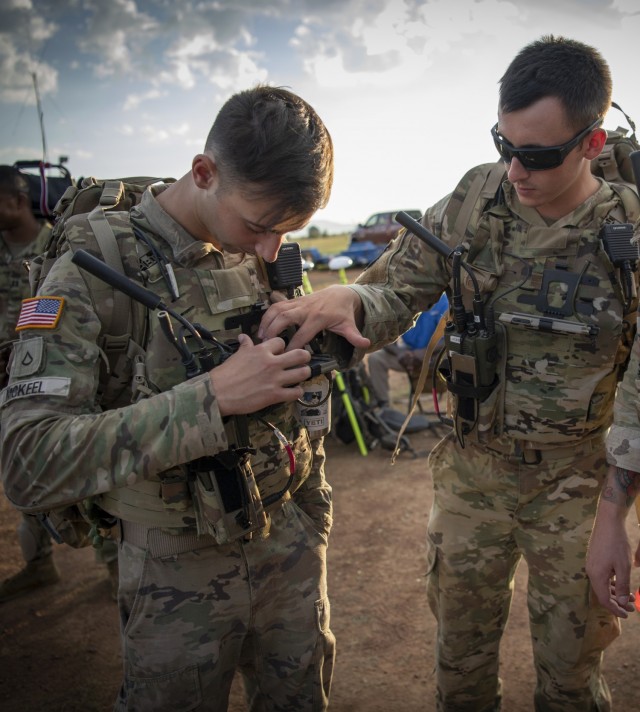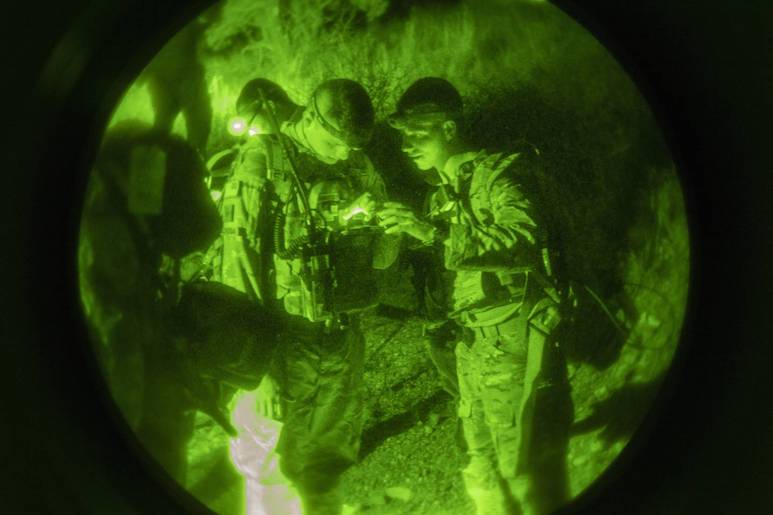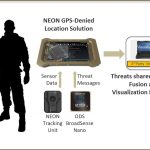The U.S. Army has put its replacement for the handheld Defense Advanced GPS Receiver (DAGR) under field testing in reconnaissance and fire missions in a variety of threat scenarios, to understand its performance in a realistic operational environment. The Dismounted Assured Positioning, Navigation, and Timing System (DAPS) could enable warfighters to better shoot, move and communicate in a GPS degraded environment.
[Photo above: Sgt. Jonathan Lechuga (left) from 2nd Battalion, 32nd Field Artillery Regiment, 1st Brigade Combat Team, 101st Airborne Division and Sgt. Dalton Jordan from 1st Battalion, 506th Infantry Regiment, 1st Brigade Combat Team, 101st Airborne Division test the new Dismounted Assured Positioning, Navigation, and Timing System (DAPS). (Nicholas Robertson/Army)]
DAPS will provide dismounted leaders Assured PNT capability in GPS-degraded and -denied environments by providing GPS integrity and non-GPS sensor augmentation as a nested capability within the Assured PNTA-PNT Ground Domain.
DAPS replaces the DAGR and/or commercial GPS on the Nett Warrior Ensemble’s End User Device (EUD), i.e., Smartphone for the Dismounted Leader. The Army anticipate sleveraging DAPS and future DAPS capabilities as part of their Military Code (M-Code) GPS compliance strategy.
Soldiers with the 2nd Battalion, 32nd Field Artillery Regiment and 1st Battalion, 506th Infantry Regiment, 1st Brigade Combat Team, 101st Airborne Division, based in Fort Campbell, Kentucky conducted night operations across rough and varied terrain of the Huachuca Mountains in southeastern Arizona.
“The Soldiers played a significant role in helping the Army develop a replacement for the legacy Defense Advanced GPS Receiver (DAGR),” said Col. Dylan Randazzo, director of the Intelligence Electronic Warfare Test Directorate.

Pfc. Cory McKeel (left), and Spc. Landon Warner from the 1st Battalion, 506th Infantry Regiment, 1st Brigade Combat Team, 101st Airborne Division prepare for a night mission during operational testing of two new GPS navigation systems that could allow the Army to work in a degraded operational environment. (Mr. Nicholas Robertson, U.S. Army Operational Test Command)
He added that the soldiers provided critical feedback regarding the resulting system’s operational effectiveness and suitability. Scenarios involved night vision goggles, nuclear, biological and chemical masks, Stryker infantry carrier vehicles, different rucksack configurations and inclement weather.
“In addition to highlighting system strengths and weaknesses,” Randazzo said, “the soldiers identified different techniques for better employment and suggestions for improvement.
While DAPS will provide Assured PNT, it will also alert the Dismounted Leader when the GPS solution may not meet mission and or situational needs. DAPS will leverage multiple sensors and timing sources in order to produce the best PNT solution possible within the operational environment.
Unlike vehicles, which have the real estate and vehicle power to accommodate robust sensor and antenna suites, DAPS has significant size, weight, and power (SWaP) constraints. Dismounted Leaders, already physically burdened with heavy equipment loads, cannot accept additional power and weight burdens. The DAPS size and weight objective is to be less than that of DAGR.
DAPS uses an iterative Development Operations (DevOps) approach to achieve Assured PNT accuracy, access, and integrity requirements, planning to develop, deliver, and field capability incrementally in a series of multiple iterations or generations. This strategy provides increased capability over time.
Each generation is designed to inform the next as to what is technically feasible, what is or can be compliant with security, cyber standards of implementation, effective, operationally viable, and finally what keeps pace with the evolving threats. The goal is to achieve an open and modular Dismounted Assured PNT solution in a SWaP constrained environment.
There are seven (7) ongoing DAPS prototyping efforts (3 under GEN 1; and one each under 1.1; 1.2; 1.2 Software Update; and 1.3).






